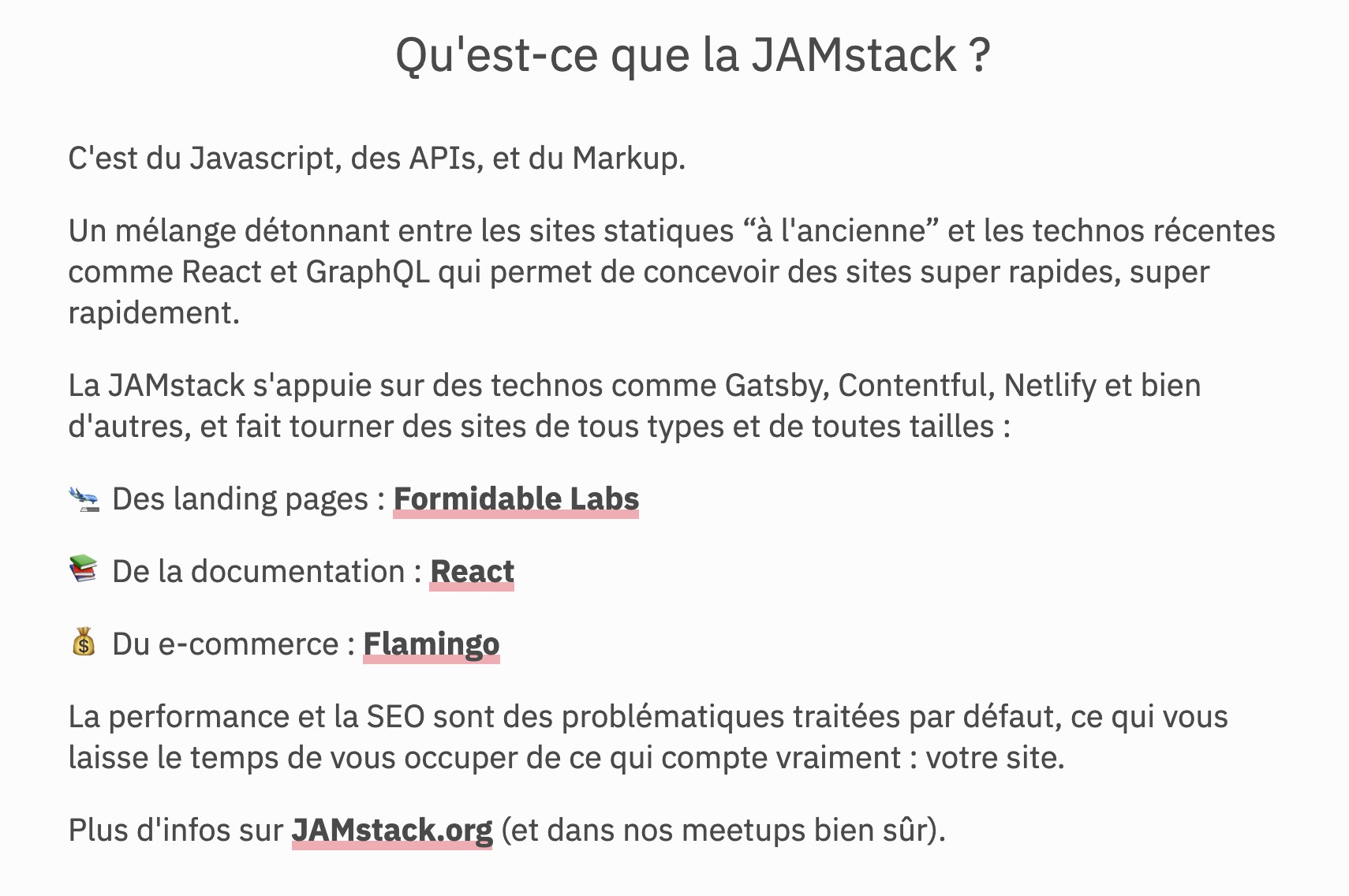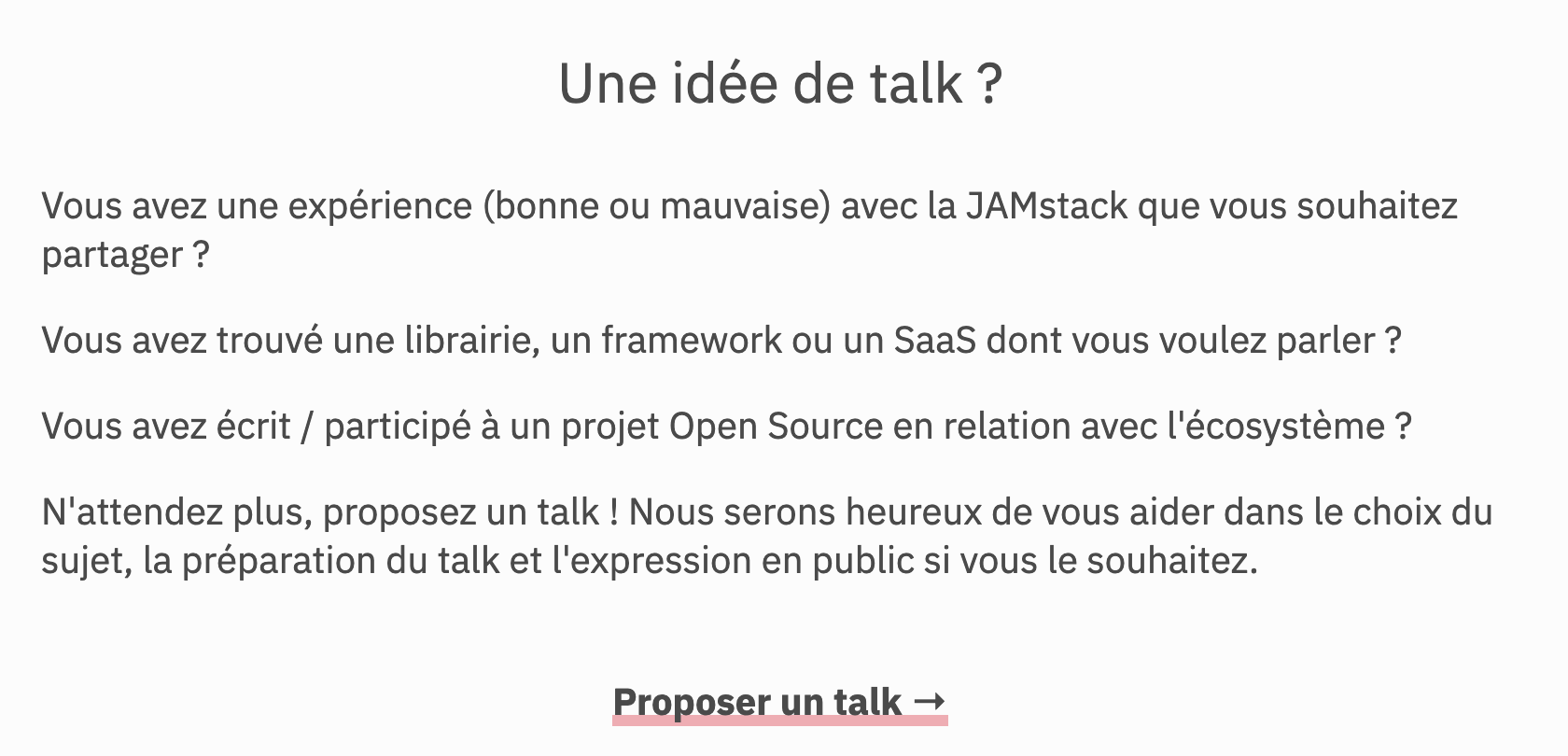@matthieuauger/gatsby-theme-meetup v1.1.9
Gatsby Theme Meetup is a simple theme for meetup organizers. Theme features includes
Past and futures meetup fetched from Meetup thanks to gatsby-source-meetup
Configurable meetup name, CFP form, videos link and editorial content powered by markdown
Translatable texts for call to action
:rocket: Get Your Meetup Site Up and Running in 5 Minutes
You can get a new Meetup Gatsby site up and running on your local dev environment in 5 minutes with these four steps:
Create you meetup site directory and bootstrap package.json.
mkdir my-awesome-meetup-website cd my-awesome-meetup-website/ npm init -yInstall Gatsby, Gatsby Theme Meetup and its dependencies.
npm install react react-dom gatsby @matthieuauger/gatsby-theme-meetupConfigure Gatsby to use the Gatsby Theme Meetup
Open the
my-awesome-meetup-websitedirectory in your code editor of choice, create agatsby-config.jsfile at the root with following lines and save your changesmodule.exports = { plugins: [ { resolve: "@matthieuauger/gatsby-theme-meetup" } ] };Set API key
Add
MEETUP_API_KEYenv variable from here: https://secure.meetup.com/meetup_api/key/Start the site in
developmode.node_modules/.bin/gatsby develop # or install Gatsby CLI globally with npm install -g gatsby-cli
At this point, you’ve got a fully functional Meetup website. For now, it fetchs and dislpay content for the JAMstack Paris Meetup.
:paintbrush: Configure site for your meetup
The theme offers simple configurations directly by modifying the gatsby-config.js file in your site directory.
:point_up: Beware, when updating your gatsby-config.js file, you must stop and start again gatsby develop so it can source the new configuration :point_up:
- Meetup Name (default: JAMstack Paris)
- Homepage Headline (default: Le meetup bimestriel autour de la JAMstack)
- Meetup.com group URL. You can get it in the URL of your Meetup (default: jamstack-paris)
- Videos Url (by default, redirect to the JAMstack Paris Youtube Page)
- Talk Proposal Url (by default, redirect to the JAMstack Paris form)
Here is an example of a gatsby-config.js configuration for the JAMstack London Meetup.
module.exports = {
plugins: [
{
resolve: "@matthieuauger/gatsby-theme-meetup",
options: {
meetupName: "JAMstack London",
meetupHomepageHeadline: "The JAMstack meetup with a cup of tea 🍵",
meetupDotComGroupUrlName: "JAMstack-London",
displayVideosLink: false,
//meetupVideosUrl = 'https://www.youtube.com/channel/UC66eQOycjMnaqzpbRUhEK2w'
talkProposalUrl: "#",
//textBlocksPath: `${__dirname}/src/text-blocks`,
dateFormat: `dddd DD MMMM YYYY`,
translations: {
PROPOSE_A_TALK: "Propose a talk →",
FETCH_VIDEOS: "See videos →",
LAST_MEETUPS: "Last meetups",
REGISTER_ON_MEETUP: "Register on Meetup →"
},
currentMeetupColor: "#EFCC74",
pastMeetupColors: ["#E6BB91", "#DDDEC4", "#F3DBD1"]
}
}
]
};:point_up: Beware, when updating your gatsby-config.js file, you must stop and start again gatsby develop so it can source the new configuration :point_up:
:writing_hand: Personalize Editorial Content
Editorial content consists of three blocks on the website.
The main text at the top of the page (usually a description of your Meetup but can be whatever)

The main text at the bottom of the page (usually a call to action for talk proposals)

The footer (usually some credits or sponsorship links)

These contents are markdown files sourced by Gatsby during build time.
To override these:
Create the text-blocks directory in your site which will contain your markdown editorial content.
mkdir -p src/text-blocksCopy the Markdown files inside your site directory.
cp node_modules/@matthieuauger/gatsby-theme-meetup/src/text-blocks/*.md src/text-blocksAdd option in the configuration to tell Gatsby to source content from your directory
module.exports = { plugins: [ { resolve: "@matthieuauger/gatsby-theme-meetup", options: { // // ... your configuration here // textBlocksPath: `${__dirname}/src/text-blocks`, // // ... you configuration here // } } ] };Edit the copied markdown files in your code editor. Beware not to change the type field at the top of the markdown files.
:point_up: Beware, when updating your gatsby-config.js file, you must stop and start again gatsby develop so it can source the new configuration :point_up:
:lipstick: Change Logo
Look at the Advanced configuration section.
:ghost: Advanced configuration
For more advanced configurations, you can use Component Shadowing. For example to override the logo.
Create the directory structure in your site which will contain your shadow component.
mkdir -p src/@matthieuauger/gatsby-theme-meetup/components/HeaderCopy the base Logo component inside your site directory.
cp node_modules/@matthieuauger/gatsby-theme-meetup/src/components/Header/MeetupLogo.component.js src/@matthieuauger/gatsby-theme-meetup/components/HeaderEdit the component and use an image of your choice
:point_up: Beware, when shadowing compopnents, you must stop and start again gatsby develop so it can load your shadowed components :point_up:
:handshake: How to Contribute
Whether you're helping us fix bugs, improve the docs, or spread the word, we'd love to have you as part of the Gatsby community! :muscle::purple_heart:
This repository contains the published package on NPM but also a fully functional development environment with Yarn Workspaces.
Pull the sources, run yarn install, yarn workspace site gatsby develop and you're ready to go.
I will read give feedbacks to new Pull Request as fast as possible.
:memo: License
Licensed under the MIT License.